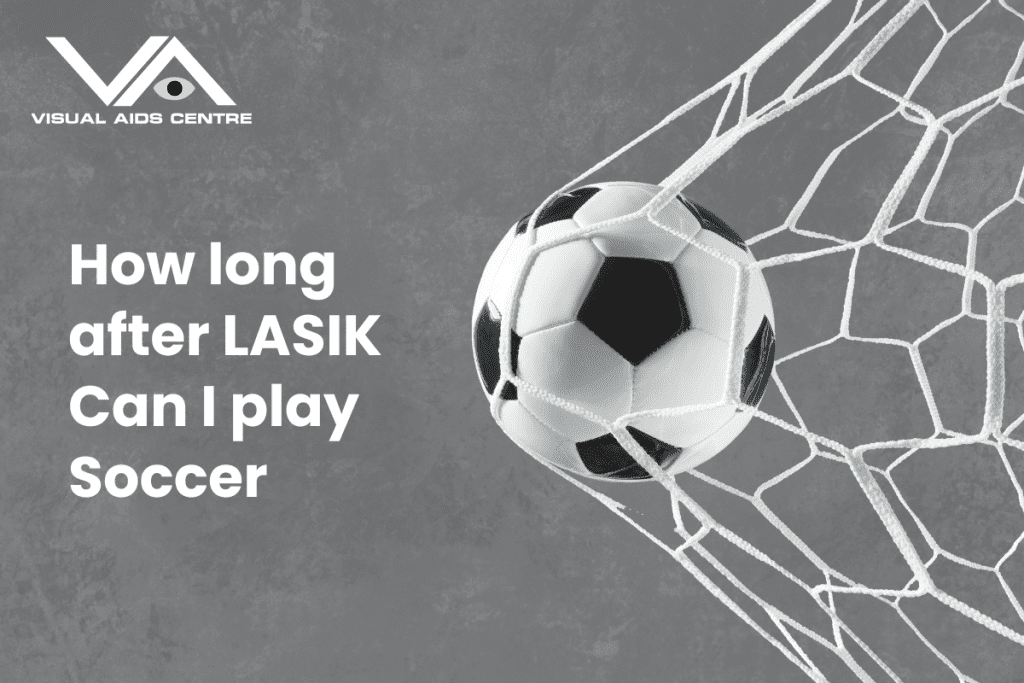Table of Contents
ToggleYou can typically return to playing soccer two to four weeks after LASIK surgery, depending on your recovery progress and your doctor’s recommendations.
However, closely following your surgeon’s guidelines is essential to ensure safety and avoid complications.
LASIK (Laser-Assisted in Situ Keratomileusis) has become a popular vision correction procedure for athletes, including soccer players, aiming to achieve clearer vision without relying on glasses or contact lenses. While LASIK’s quick recovery time is one of its most significant advantages, resuming physical activities like soccer requires caution.
To help you make a smooth and safe transition back to the field, this blog outlines the key considerations, recovery timeline, and safety tips to avoid setbacks during your recovery.

Understanding the Recovery Timeline
While LASIK surgery has a high success rate and minimal downtime, recovery occurs in stages. Soccer players must carefully adhere to this timeline to prevent injuries, infections, or complications.
First 24-48 Hours After Surgery
- Visual Clarity: Immediately after LASIK, you’ll likely notice improved vision. However, your vision may be blurry or fluctuate during the first 24-48 hours.
- Rest Period: Rest is critical. Avoid excessive screen time or outdoor exposure that may strain your eyes or expose them to irritants.
- Physical Activity Restrictions: Soccer, or any vigorous activity, is strictly off-limits during this time. Even minor impacts or accidental rubbing of your eyes can interfere with healing.
Week 1 Post-Surgery
- Protect Your Eyes: During the first week, it’s essential to protect your eyes from dust, sweat, and accidental contact. Your surgeon will likely recommend wearing protective eyewear.
- No Physical Contact: Avoid high-impact activities, including soccer, even if you feel fine. The corneal flap created during LASIK requires time to fully heal and stabilise.
- Symptoms to Expect: It’s normal to experience mild dryness, light sensitivity, or halos around lights. Use prescribed eye drops as directed to address these.
Weeks 2 to 4
- Cautious Return: By the second or third week, many patients receive clearance to resume light non-contact exercises, such as jogging or basic stretches. However, playing soccer prematurely remains risky at this stage.
- Gradual Clearance: Some athletes may receive surgeon approval to return to contact sports between the third and fourth weeks, depending on their healing progress. Always consult your doctor before stepping back onto the field.
After One Month
- Resume Play: Most LASIK patients can confidently return to playing soccer about one month after the procedure. By this time, the corneal flap should be stable, and your vision should be clear.
- Protective Eyewear (Optional): Although not mandatory, wearing sports goggles can minimise the risk of eye injuries while playing.
Why Wait to Play Soccer After LASIK?
It might be tempting to jump back into soccer soon after surgery, especially as you enjoy your newfound vision clarity. However, there are critical reasons why waiting is crucial:
1. Corneal Flap Healing
LASIK involves creating a thin flap on the cornea, which requires time to heal and stabilise. Physical impact or rubbing during sports could dislodge or damage this flap, leading to complications like wrinkles or infection.
2. Reduced Risk of Infection
Sweat, dirt, and bacteria commonly encountered on the soccer field increase the likelihood of eye infections when your eyes are still recovering.
3. Avoiding Dry Eye Aggravation
Post-LASIK dryness is common. Wind, physical exertion, and exposure to outdoor elements during soccer can exacerbate this symptom.
4. Stability of Vision
Your vision might fluctuate during the first weeks after surgery. Playing soccer with unstable vision could affect your performance and risk-setting movements, especially on the field.
Signs You’re Ready to Return to Soccer
Before resuming soccer, ensure that you’ve met the following milestones to prevent compromising your recovery:
- No major light sensitivity
- No signs of redness or irritation
- Consistently clear and stable vision
- Surgeon clearance for contact sports
- Minimal to no dryness with regular use of lubricating drops
If any symptoms like pain, blurred vision, or prolonged discomfort occur, avoid returning to play and consult your doctor immediately.
Tips for Safely Returning to Soccer After LASIK
1. Follow Your Doctor’s Advice
Every individual’s healing timeline varies. Rely on your doctor’s expertise rather than rushing back to action.
2. Wear Protective Eyewear
Sports goggles or shatterproof glasses can shield your eyes from dust, sweat, and potential trauma.
3. Ease into Training
Start with light practice sessions instead of jumping straight into full-contact games. Focus on building endurance and coordination while monitoring your eyes’ response to activity.
4. Use Artificial Tears
Keep your eyes hydrated by using lubricating drops, especially during outdoor practices or matches, to prevent dryness.
5. Avoid Overexertion
While building stamina, avoid overexerting yourself too quickly. Gradual progress ensures your eyes and body adapt to physical demands.
6. Monitor for Symptoms
Pay attention to any signs of irritation, discomfort, or vision changes during or after play, and inform your doctor if you notice anything unusual.
When to Seek Medical Attention?
Although LASIK complications are rare, certain symptoms may require prompt medical attention:
- Persistent redness or pain
- Significant changes in vision clarity
- Sensitivity to light that doesn’t improve
- Excessive discharge from the eyes
If these occur, stop all physical activity—including soccer—until you’ve consulted your doctor.
LASIK Benefits for Soccer Players
Soccer players who undergo LASIK often enjoy several long-term benefits once they’re cleared to return to the field:
- Enhanced Performance: Crisp, clear vision can improve your depth perception, peripheral awareness, and overall game performance.
- No Dependency on Corrective Lenses: Say goodbye to the inconvenience of glasses or contact lenses that could fog up or get displaced during play.
- Confidence Boost: Knowing your vision is sharp can enhance your focus, concentration, and confidence on the field.
Final Thoughts
Most soccer players can safely return to matches within one month of LASIK, following appropriate recovery and professional guidance. Prioritising your healing process ensures long-term success—both on and off the field.
If you have specific concerns about your recovery or need tailored advice, always consult your LASIK surgeon. With patience and proper care, you’ll soon be ready to return to the game with a clearer view and improved performance.









